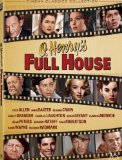Synopsis
John Steinbeck, looking and sounding remarkably like James Ellroy, and coming across as surprisingly two-fisted given the overall tone of the movie, introduces a quintet of stories by O. Henry. “The Cop and the Anthem” features Charles Laughton as a dignified bum trying unsuccessfully to get himself arrested so he can spend the winter in a nice, warm prison (Marilyn Monroe is one of the top-billed, but she has only one brief scene here). “The Clarion Call” has Dale Robertson as a detective w…o realizes that a wanted murderer is, in fact, a childhood friend to whom he owes a huge debt. The friend is played by Richard Widmark, who shamelessly recycles his psycho act from Kiss of Death, right down to the hyena laugh. In “The Last Leaf,” Anne Baxter struggles to convince her pneumonic sister (Jean Peters) that life is worth living. “The Ransom of Red Chief” is the tale of two con-men (Fred Allen and Oscar Levant) who kidnap a young boy and very quickly wish they’d never clapped eyes on the holy terror. And “The Gift of the Magi,” the most famous story of the bunch, is the Christmas tale of a young couple (Jeanne Crain and Farley Granger) who give up their most treasured possessions in order to buy each other a special gift.
There’s a pretty even mix of sentiment and humour here. “The Clarion Call” is the exception, playing out as a mini film noir, and the standout is “The Ransom of Red Chief,” where, under the expert direction of Howard Hawks, hilariously ornate dialogue, devastating deadpan deliveries and terrific sight gags meld together in a delicious concoction.
Audio
You have your inevitable choice between the original mono and a 2.0 mix. Clarity isn’t a problem, there is no hiss, and nor is there any distortion. There is some wraparound dialogue happening, but it’s pretty subdued, only noticeable if you really pay attention. The overall volume is, however, a bit weak.
Video
The print has been very nicely restored. The black-and-white tones are strong (though perhaps the contrast is a little too high), and the blacks themselves are fabulous. Damage is almost non-existent, and the grain is held to a minimum. The image is sharp. Really, one can’t imagine a film from 1952 looking much better than this.
Special Features
O. Henry scholar Jenny Lind Porter provides the commentary. She’s great on O. Henry, but she clearly isn’t a film scholar, and she spends too much time describing what we are seeing. “The Life and Writing of O. Henry” is a self-explanatory featurette, while “The O. Henry Museum” is a guided tour through his home. The original exhibitor’s campaign book is here in interactive form (very nice), and the real treat is two other O. Henry adaptations from 1927: “Girls” and “A Man About Town.” Rounding things out are a still gallery and a restoration comparison.
Closing Thoughts
Plenty of charm and sentiment (largely unsticky) on display here, and the film is good, it’s great.
Special Features List
- Audio Commentary
- “The Life and Writing of O. Henry” Featurette
- “The O. Henry Museum” Featurette
- Original Exhibitor’s Campaign Book
- 2 O. Henry Shorts from 1927
- Still Gallery
- Restoration Comparison





